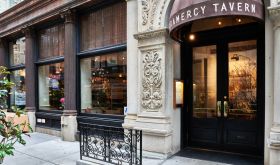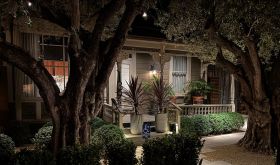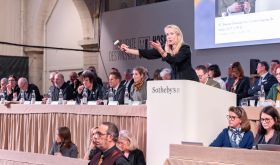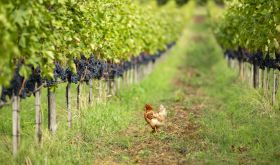On my first visit to Bilbao in northern Spain 30 years ago my lack of Spanish prevented me from even getting a drink in the first three tapas bars I visited. I had assumed that Spanish for beer was something like its English, French or Italian counterpart (rather than cerveza) and my requests for one were greeted with incomprehension until in the fourth bar the waiter handed me a glass of red wine, having understood my request as bino or a glass of wine. This, subsequent glasses and the constant stream of tapas that followed were my unforgettable introduction to Basque cuisine.
These memories came flooding back as we stood at the bar in the crowded Café Bilbao in the Plaza Berria taking stock having just discovered that Victor Montes, the characterful restaurant next door to which we had been highly recommended, was temporarily closed for renovation. Fortunately, I now know enough Spanish to order a couple of glasses of Rioja and tapas of ham and creamy cod topped with a pungent garlic mousse as we browsed the city map and decided on our next move.
Minutes later, as the rain turned to hail, I found myself retracing my steps of 30 years ago but in reverse this time, away from the old town, past a tapas bar suitably named Don Jamon for the 20 or more haunches of ham hanging above the bar, and along the rather splendid if cold Gran Via, home to various banks, insurance offices, department stores and comfortable apartment blocks.
We were heading to Guria, a bar, café and restaurant that despite a clean and modern interior still evoked that old world charm of so many Spanish restaurants. Leather chairs; heavy curtains; lousy lighting and even worse piped music but, on the plus side, two maternal waitresses and a maitre d’ whose face positively lit up when I ordered the house special of the neck of hake sautéed with numerous, pungent slivers of garlic.
Despite the presence of small pieces of frizzy parsley and crescents of pastry on the plates, touches rarely seen today, a salad of endive and local blue cheese, the hake, a slightly caramelised rice pudding infused with orange flower water and the tuiles with the petits fours reassured us that there was considerable expertise in the kitchen. Our bill with a refreshing bottle of the Basques’ bracing young white Txakoli [Senorio De Otxaran 2003, 11.5 per cent alcohol and the finest we came across JR] came to 97 euros excluding service. Eating in the brasserie section next to the bar would be cheaper and might well be more fun, although Bilbao’s many fur-coated matrons obviously head straight for the formal restaurant section in the back where we ate.
The only connection between this long-established but still individual face of Bilbao and the recent, ultra-modern additions exemplified in Frank Gehry’s breath-takingly audacious Guggenheim Museum seemed to be the kindly-faced woman in charge of cooking the eggs for the generous breakfast buffet on the seventh floor terrace of the determinedly hip Gran Hotel Domine overlooking the museum. The brownie points won by the hotel’s large water feature in the atrium which incorporates plates, wine and champagne glasses were somewhat dissipated by the name of its bar, Splash and Crash, which even boasted a painting of a car crash on one wall.
Jeff Koons’ huge statue ‘Puppy’ covered with pansies at the entrance to the museum cannot fail to bring a smile to anyone’s face. As did the entire interior of the museum which, even if it does not contain as many extraordinary works as other new museums, is designed to induce awe and is of a size to induce a good appetite.
The Guggenheim Museum boasts a cafeteria on the ground floor and another on the second floor which in turn leads into a small restaurant that offers a well-priced menu of the day and immediately adjacent a ‘gastronomic restaurant’ in conjunction with chef Martin Berasategui who runs one of Spain’s most respected restaurants in Lasarte, just outside San Sebastian.
Eschewing the more expensive option in anticipation of eating in Lasarte we settled for the less expensive restaurant which at the outset seemed to offer extremely good value. During the week a three-course meal costs 13 euros while at the weekend and on holidays it rises to the rather strange price of 17.03 euros, plus 7% VAT in both cases, with an even less expensive childrens’ menu.
And there were some intriguing dishes at each course: zurrukutuna, a garlic and vegetable soup with cod confit; ravioli of mushrooms; thin slices of rare roast beef with red peppers; piquillo peppers stuffed with seafood; cod fillet with cabbage and more garlic; cannelloni stuffed with oxtail; French toast as a sweet course; a pineapple and banana cream; and a milk and anisette curd.
But from the moment our waitress came to take our order the excitement engendered by the museum fell away. Perhaps it was her insistence on taking our dessert order at the outset – a practice I strongly object to – perhaps it was the tepid soup or most likely it was the kitchen’s habit of sending out the main courses not by table but by dish so that all those eating the cod got theirs at the same time while those who had ordered the peppers had to wait several minutes.
But I think it was principally because in such a magnificent museum those who choose to eat the less expensive menu are seated in much the less attractive space segregated from the more select ‘gastronomic’ area by the back of a metal barrier and, where that ends, by a piece of rope. That is not what the modern movement is all about.
Café Bilbao, 94.415.16.71
Victor Montes, Plaza Nueva 8, 94.415.70.67
Restaurante Guria, Gran Via 66, 94.441.05.43
Gran Hotel Domine Bilbao, www.granhoteldominebilbao.com












